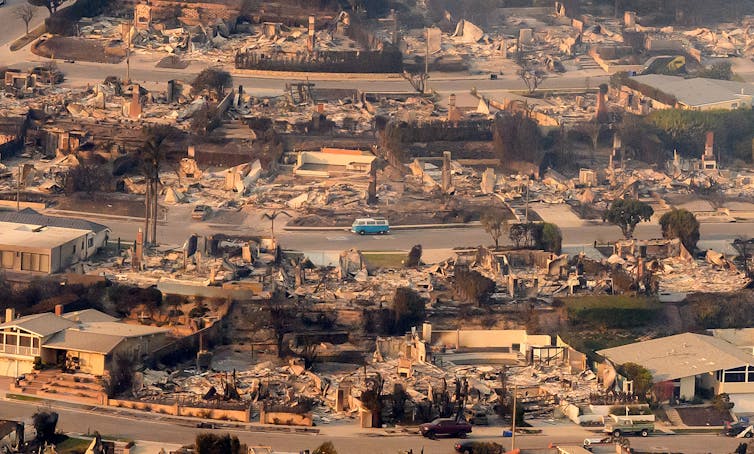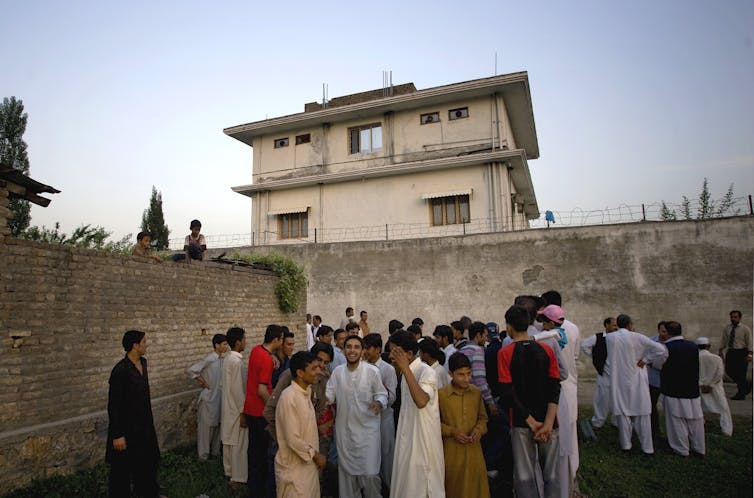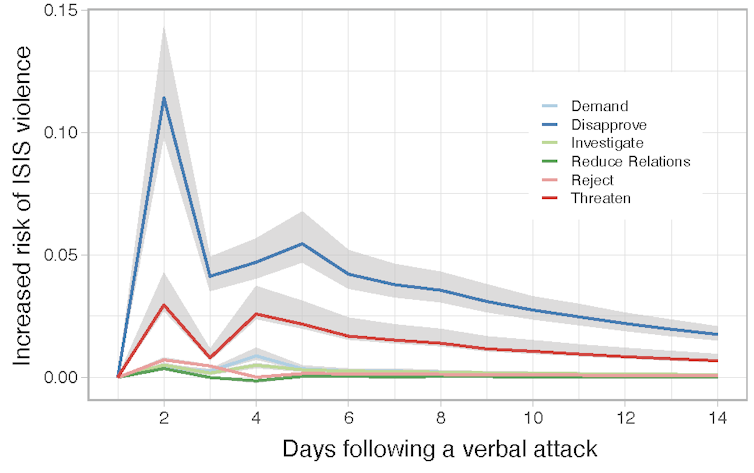
AFP via Getty Images
Collin J. Meisel, University of Denver
With major conflicts in Africa, the Middle East, Europe and Southeast Asia, 1 in 8 people worldwide were exposed to conflict in 2024 – proving another fraught year in terms of human suffering on a mass scale. In fact, 111 countries around the world experienced some form of mass atrocity during the year.
That’s what colleagues and I at the University of Denver’s Pardee Institute confirmed when analyzing our updated global dataset on recent and ongoing mass atrocities.
Covering nearly 200 countries, the goal of the project is to go beyond any single tragedy or conflict and objectively try to determine the level of humanitarian suffering in places around the world. Each country is then assigned a 0-100 score on our Atrocities Scope and Scale Heuristic – providing a single metric for the breadth and severity of atrocities committed within a certain year.
In the project, we define mass atrocity as an act of violence against 25 or more defenseless members of a social, cultural, ethnic, religious or political group — or threats to the group’s survival.
Although we saw fewer atrocities globally in 2024 than in 2023, there were still more than in any other year since 2018. And while lethal atrocities were fewer in number in 2024 relative to the previous year, several types of “less lethal” atrocities – actions involving gross, intentional violations of human rights on a mass scale short of murder – were more numerous.
From worst to still bad
In 2023, the situation was bleak across the board. More than 1 million people were forcibly displaced from their homes in war-torn Ukraine and the Gaza Strip. Tens of thousands of civilians were killed across Southeast Asia, the Middle East and Eastern Europe. And in the first few months of Israel’s war in Gaza, the daily death rate was higher than any other conflict in the 21st century.
In 2024, there was a slight decrease in the total magnitude of atrocities relative to the prior year, though much of the worldwide suffering continued. By the end of the year, roughly 19 in 20 Palestinians living in Gaza had been forcibly displaced at least once, and most, several times. After nearly four years of civil war, mass murder of civilians in Myanmar’s ongoing conflict continued apace. The country’s ruling junta tortured and reportedly burned people alive, and both the military and rival Arakan Army rebel group are alleged to have engaged in ethnic cleansing of Rohingya Muslims, with ethnic tensions rippling across the border into India.
In the Democratic Republic of the Congo, the humanitarian situation also remained grim. The Congolese government began to eject United Nations peacekeepers and those of a regional African peacekeeping force after getting fed up with the U.N.’s inability to quell the violence in Congo’s North Kivu and Ituri provinces – northeastern regions of the country plagued by murder and rape from groups like the Rwanda-backed M23 militia.
Sudan provided another egregious example of the escalation of atrocities in 2024. As the civil war raged on, the Rapid Support Forces paramilitary group committed numerous extrajudicial executions of Sudanese military forces. This came against the background of widespread sexual slavery and other atrocities within Sudan’s combat zones – including those perpetrated by the Sudanese military itself, like the bombing of civilian targets.
Incidents of what my team deem to be lower-level atrocities persisted elsewhere and outside of active humanitarian crisis zones, from groups in South Africa attacking Zimbabwean migrants for suspected “witchcraft” to German police beating Palestinians during last spring’s international protests against the war in Gaza. Only 84 countries – or fewer than half of those my team tracks – escaped 2024 without a single recorded lethal or less-lethal mass atrocity. That number was the same as in 2023, but notably worse than the 97 countries that appeared to be atrocity-free in 2018.
Across the 2018 to 2024 period, several countries that have persistently seen atrocities take place – including Ukraine, Israel and the Occupied Palestinian Territories, Congo, Sudan and Russia – have seen an uptick in recent years.
On the brighter side, humanitarian conditions improved in several countries in 2024. In Bahrain, for example, King Hamad bin Isa Al Khalifa marked the end of Ramadan by freeing hundreds of political prisoners – although hundreds more remain in arbitrary detention. While political imprisonment increased in Azerbaijan in 2024, the overall level of violent atrocities waned substantially relative to 2023 as the country’s leaders sought to complete a peace treaty with Armenia. Conditions in Venezuela, Eritrea and Mexico have also improved substantially from prior years, even if they remain far from good.
Overall, 2024’s record of atrocities and attempts to quell them was mixed. There appeared to be less mass murder than in 2023 and less nonlethal violence in the form of torture, beatings and related force. But we saw other unwelcome increases in violence. There was a global increase in the conscription of child soldiers, with Haiti seeing a 70% increase relative to the year before. In Afghanistan, the Taliban’s morality law, enacted in summer 2024 – which human rights groups said targeted women, LGBTQ+ groups and religious minorities – coincided with a broader global trend toward less equal treatment of minority groups by the law.
And there was widespread group violence against women in Afghanistan and beyond. The U.N. estimated that one woman was killed every 10 minutes in 2023. Our data suggests this statistic is unlikely to have improved for 2024.
Prospects for the year ahead
Where does this leave us for 2025?
The opportunity for a finalized peace deal between Azerbaijan and Armenia remains open, and with it the potential for a significant reduction in violence. Far more consequential would be an end to the wars in Ukraine and Gaza – though here as well the prospects for lasting peace are uncertain.
Sadly, we can expect far more human suffering in Congo, Myanmar and Sudan, where their respective conflicts show no clear end in sight.
Tracking atrocities in the meantime may help. If nothing else, then in the words of Holocaust survivor, activist and Nobel laureate Elie Wiesel, we can – and should – continue to bear witness. By systematically doing so, we increase the chance that perpetrators will one day be held accountable. We also improve our ability to track where perpetrators have not been held accountable, opening conversations around how such challenges may be better dealt with in the future.![]()
Collin J. Meisel, Associate Director of Geopolitical Analysis, Pardee Institute, University of Denver
This article is republished from The Conversation under a Creative Commons license. Read the original article.





















































